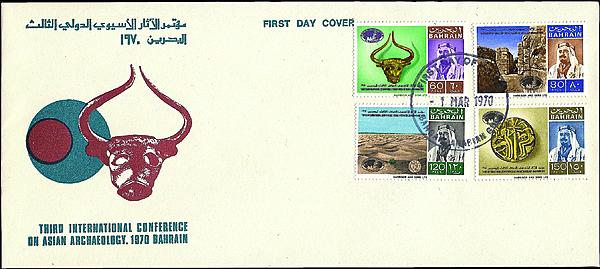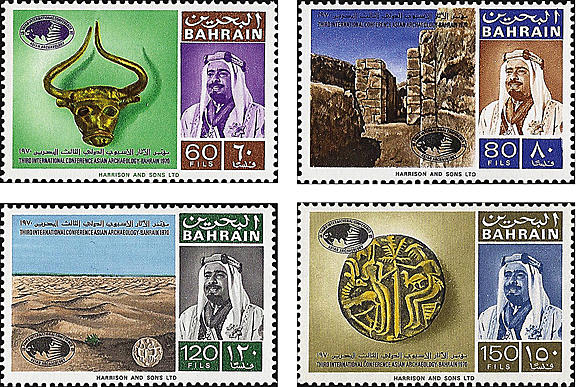World Stamps
Bahrain stamps honor international archaeology conference
On March 1, 1970, the third International Conference on Asian Archaeology opened in Bahrain. In honor of the occasion, Bahrain issued four commemorative stamps on that date.
The set (Scott 173-176) is valued in the 2015 Scott Standard Postage Stamp Catalogue at $41 mint, never hinged in the grade of very fine and $13.50 used.
Harrison and Sons Ltd. of the United Kingdom printed these stamps by photogravure on white, unwatermarked paper. The stamps are perforated gauge 14½.
The denominations are 60 fils, 80f, 120f and 150f. As of 1966, 1,000 fils are equivalent to 1 dinar.
The quantities issued were small: 100,000 of the 60f stamp, and 50,000 each of the other three denominations. Thus, only 50,000 complete sets can be assembled.
The design of these colorful and attractive stamps consists of two parts.
The right side of each stamp depicts the ruler of Bahrain, Sheikh Isa bin Sulman Al-Khalifah. Above his portrait is the name of the country in both English and Arabic. The denomination and currency are inscribed below the portrait, in English at left and in Arabic at right.
Archaeological discoveries made in Bahrain are shown on the left side of the stamps’ designs.
The 60f stamp features a copper bull’s head from the temple of Barbar, built approximately 4,000 years ago. This archaeological site was named after the village of Barbar in northern Bahrain.
The 80f denomination shows ruins of this stone temple.
The 120f stamp depicts Bahrain’s tumuli, the largest prehistoric burial mounds of the world. Dating to 2,000 B.C., the mounds are the grave sites of thousands of people of the Dilmun era, one of the oldest civilizations known to exist in the Middle East.
The 150f value portrays a Dilmun circular stamp seal.
The left side of all four stamps also includes the conference emblem and the inscription “Third International Conference Asian Archaeology – Bahrain 1970” in English and Arabic.
Appearing in the margin below the design on all four stamps is the name of the printer “Harrison and Sons Ltd.”
Official first-day covers were sold at the post office for $1.15 each.
The four stamps are affixed to the right side of the cover, tied with a circular first-day cancel with the March 1, 1970, date.
The illustration on the left side of the cover features the copper bull’s head partly imposed on what appears to be a clay pot.
Below this illustration is the text “Third International Conference on Asian Archaeology. 1970 Bahrain,” with the same text above the illustration, but in Arabic. The words “First Day Cover” appear in the center of the cover at the top.
The first and second International Conferences on Asian Archaeology were held in India and Sri Lanka.
At these conferences, representatives of Asian countries who specialize in antiquities and scholars working in the field of Asian archaeology would discuss and review the progress and problems occurring within Asian archaeology. The focus of each conference was specific to the host country.
Holding the third conference in Bahrain was a huge event for the country for two reasons. It was the first time that Bahrain joined other archaeologically minded countries in highlighting its buried treasures. It also was the first time that an international conference was held in the Arabian Peninsula.
This third conference showcased the 16 years of archaeological research that had occurred on Bahrain Island.
In 1953, the government, under the auspices of Sheikh Sulman bin Hamad, father of Sheikh Isa, sponsored this research to be conducted by Danish archaeologists.
The discoveries were amazing, extending the history of this island by about 5,000 years. These findings also identified Bahrain as the capital of the kingdom of Dilmun.
The stamps of Bahrain appeal to a large number of collectors because of their attractive designs and the numerous topics they represent. The stamps are affordable and have interesting stories behind them.
Add a piece of Bahrain’s history to your collection. You will not be disappointed.
MORE RELATED ARTICLES
Headlines
-
US Stamps
Oct 7, 2024, 3 PMMcMurtrie dismissed as APS education director following Sept. 21 arrest
-
US Stamps
Oct 7, 2024, 12 PMVasiliauskas named president of Mystic Stamp Co.
-
US Stamps
Oct 6, 2024, 5 PMApgar souvenir card available
-
US Stamps
Oct 6, 2024, 4 PMFirst Continental Congress and U.N. stamps receive Scott catalog numbers







